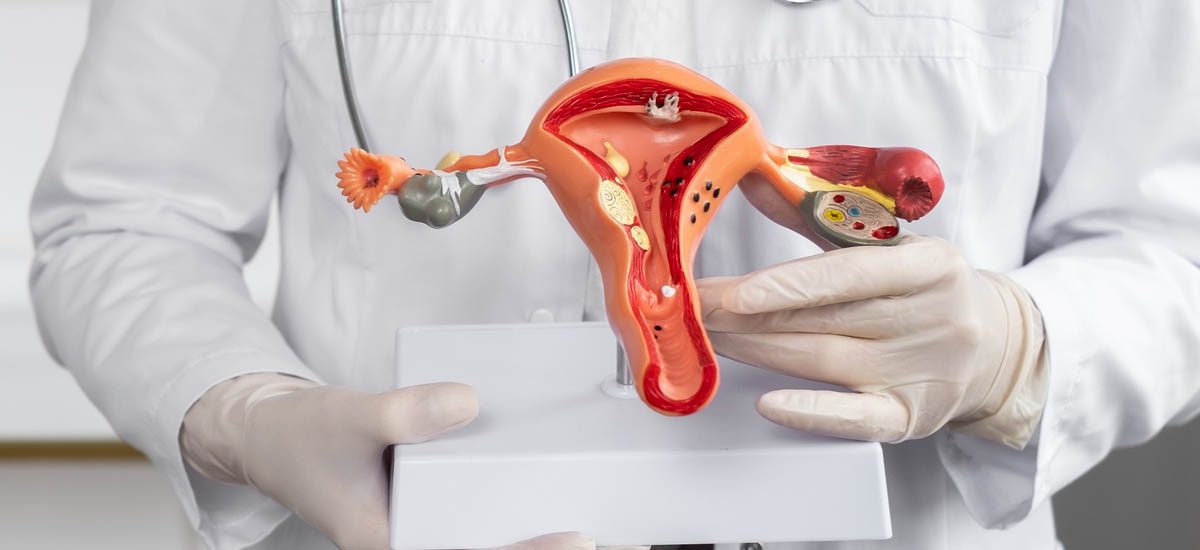Endometriosis

In the world of infertility and its treatment, endometriosis is a dreaded word, the supervillain of conditions that could render a woman infertile! Let’s understand what this disease about. The name is derived from the word endometrium, which is the innermost lining of the uterus. It is this layer than undergoes cyclical changes in responses to the hormones secreted by the ovaries. So in the first half of the cycle, the tissue of the endometrial layer grows in thickness and density. Components of the tissue such as glands, blood vessels, connective tissue etc grow in number. When they have reached the optimal growth typically ovulation occurs and there is the shift in the hormonal milieu of the body, which causes the endometrial tissue to become more receptive to the incoming embryo (if there is one) so that implantation and pregnancy can occur.
In cycles where pregnancy has not occurred the hormonal secretion stops and
causes the breakdown and shedding of the endometrium (menses). And the entire process repeats itself. It is obvious that this tissue is highly specialized for this function and thus can and should only be present in the interior of the uterus. But in some women, this tissue is present at other sites such as the ovaries, fallopian tubes, intestinal walls, peritoneum and very rarely can even be found in the lungs etc. This situation or condition is known as endometriosis. There is no consensus as to the cause of endometriosis. No one theory or explanation is able to explain all the aspects of endometriosis. On the surface, the disease appears to be cancer because of:
- Presence of endometrial tissue at distant sites indicating the spread of the cells or the spontaneous change in cells.
- Invading nature of the endometriotic implants.
But it is NOT A CANCER!

How Does It Cause Infertility?
The presence of endometriotic tissue at other sites causes problems because like the endometrium in the uterus, these tissue implants also sow cyclical growth and degeneration, but unlike the uterine tissue these implants have no outlet for the degenerated tissue to exit the body. Thus the degenerated tissue and blood accumulates in the ovaries, around the tubes, intestines etc and causes local inflammation, adhesion formation, because of which:
- the tubes and ovaries lose their mobility
- the egg-picking action of the tube is lost
- Cysts may develop in the ovary destroying the normal egg cells
- adhesions between intestines and pelvic structure (uterus, tubes and ovaries) distorts the normal anatomy
- the inflammation caused by the endometriotic implants makes the pelvic environment hostile to sperms.
What Are The Symptoms And Signs Of Endometriosis?

- Severe dysmenorrhea (painful menstruation): This is usually debilitating and the woman is usually forced to take a leave of absence from work/studies etc.
- Chronic pelvic pain: in some severe cases there is the presence of dull aching pain in the pelvis at all times. This pain could be aggravated by sexual intercourse, defecation, pelvic examination (by a doctor) etc.
- Infertility
- Ultrasound evaluation of the pelvis may show the presence of endometriomas aka chocolate cysts (ovarian cysts, hallmark sign of ovarian endometriosis).
- Pelvic examination may elicit pain deep in the pelvis and also reveal that the uterus is less mobile than a normal uterus (due to adhesions to the intestines).
Diagnosis
The gold standard test or procedure to diagnose endometriosis is Diagnostic Laparoscopy. This procedure enables the clinician to have a look into your pelvis and see for real, the situation there! The pelvic organs, their anatomical relation to each other, the pliability and functioning of the tubes, the mobility and structure of the uterus and ovaries etc can be seen clearly and understood. Small
endometriotic implants or adhesions that cause infertility, which may be missed by ultrasound scan and other imaging modalities can be picked by laparoscopy and also treated at the same sitting. The only disadvantages being, the invasiveness of the procedure and its cost.
Treatment
As the disease is caused and aggravated by the cyclical development and destruction of the endometrial tissue, all treatment modalities are geared towards temporarily or permanently stopping this cycle.
Pseudo pregnancy: taking oral contraceptive pills tricks the body into believing that it is pregnant. Thus ovulation is inhibited and cyclical changes of the endometrium are absent. Thus there is relief from the symptoms for the duration of the pill but may recur once they are stopped.
Pseudo menopause: GnRH agonist depot injection may be given to shut down gonadotrophin hormone secretion from the brain thus mimicking a menopause like situation, which again prevents cyclical changes in the endometrium. Again the symptoms may recur once the treatment is stopped and also this treatment is associated with all the other distasteful symptoms of menopause such as hot flashes, mood swings, loss of bone mineral density etc.
The treatments mentioned above are symptomatic and not to be used for women trying to conceive.
For infertile patients, the best approach would be to perform a diagnostic laparoscopy, clear out any endometriotic implants and then proceed with ART (assisted reproductive techniques) so as to get pregnant as soon as possible. If scans reveal the presence of endometriotic cysts then an operative laparoscopy is imperative, again followed by ART.
Take Home Message:
Endometriosis is a progressively worsening disease, which causes disfigurement and functional impairment of the female pelvic structures. Thus treatment must be initiated at the earliest to prevent further damage and to restore the functionality of the organs as early as possible. Also, try not to delay conception as much as possible.



